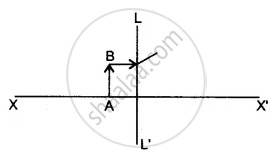Advertisements
Advertisements
प्रश्न
Two lenses A and B have focal lengths of +20 cm and, −10 cm, respectively.
(a) What is the nature of lens A and lens B?
(b) What is the power of lens A and lens B?
(c) What is the power of combination if lenses A and B are held close together?
उत्तर
(a) The focal length of lens A is +20 cm. The positive sign indicates that lens A is convex, i.e., a converging lens.
The focal length of lens B is -10 cm. The negative sign indicates that lens B is concave, i.e., a diverging lens.
(b) Focal length of lens A, fA = +20 cm = +0.20 m
∴ Power of lens `A, P_A=1/(f_A)=1/0.20=5D`
Focal length of lens B, fB = -10 cm = -0.10 m
∴ Power of lens B, `P_B=1/f_b=1/-0.10=-10D`
(c) When lenses are combined, the power of the combination is the algebraic sum of the powers of the individual lenses.
∴ Power of combination of lens A and B,p=P_A=P_B
` P=5D-10D=-5D.`
APPEARS IN
संबंधित प्रश्न
Define the power of a lens.
A student uses a lens of focal length 40 cm and another of –20 cm. Write the nature and power of each lens
A convex lens of power 5 D and a concave lens of power 7.5 D are placed in contact with each other. What is the :
(a) power of this combination of lenses?
(b) focal length of this combination of lenses?
On reducing the focal length of a lens, its power ______.
A double convex lens has two surfaces of equal radii R and refractive index \[m = 1 \cdot 5\]
A symmetric double convex lens is cut in two equal parts by a plane containing the principal axis. If the power of the original lens was 4 D, the power of a divided lens will be
Complete the diagram to show the formation of the image of the object AB.

(i) Name the Lens LL’.
(ii) Where is the image of the object AB formed?
(iii) State three characteristics of the image.
Focal length : metre : : power of lens : _______
The focal length of a concave lens is 20 cm. The focal length of a convex lens is 25 cm. These two are placed in contact with each other. What is the power of the combination? Is it diverging, converging or undeviating in nature?
The same size images are formed by a convex lens when the object is placed at 20 cm or at 10 cm from the lens. The focal length of convex lens is ______ cm.
